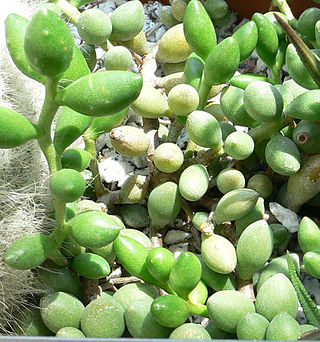
Peperomia is one of the two large genera of the family Piperaceae. It is estimated that there are at least over 1,000 species, occurring in all tropical and subtropical regions of the world. They are concentrated in South and Central America, but may also be found in the southern North America, Caribbean islands, Africa, Oceania, and southern and eastern parts of Asia. The exact number of species is difficult to determine, as some plants have been recorded several times with different names, and new species continue to be discovered. Peperomias have adapted to many different environments and their appearances vary greatly. Some are epiphytes or lithophytes, and many are xerophytes or possess underground tubers (geophytes). Most species are compact perennial shrubs or vines.

Euphorbia is a very large and diverse genus of flowering plants, commonly called spurge, in the family Euphorbiaceae. "Euphorbia" is sometimes used in ordinary English to collectively refer to all members of Euphorbiaceae, not just to members of the genus.

The Crassulaceae, also known as the stonecrop family or the orpine family, are a diverse family of dicotyledon flowering plants characterized by succulent leaves and a unique form of photosynthesis, known as Crassulacean acid metabolism (CAM). Flowers generally have five floral parts. Crassulaceae are usually herbaceous but there are some subshrubs, and relatively few treelike or aquatic plants. Crassulaceae are a medium size monophyletic family in the core eudicots, among the order Saxifragales, whose diversity has made infrafamilial classification very difficult. The family includes approximately 1,400 species and 34–35 genera, depending on the circumscription of the genus Sedum, and distributed over three subfamilies. Members of the Crassulaceae are found worldwide, but mostly in the Northern Hemisphere and southern Africa, typically in dry and/or cold areas where water may be scarce, although a few are aquatic.

The Aizoaceae, or fig-marigold family, is a large family of dicotyledonous flowering plants containing 135 genera and about 1800 species. They are commonly known as ice plants or carpet weeds. They are often called vygies in South Africa and New Zealand. Highly succulent species that resemble stones are sometimes called mesembs.

Cotyledon is one of some 35 genera of succulent plants in the family Crassulaceae. Mostly from Southern Africa, they also occur throughout the drier parts of Africa as far north as the Arabian Peninsula. Ten of its species are mostly confined to South Africa, where unlike Tylecodon, they occur commonly in both the winter and summer rainfall regions. They may be found on coastal flats and rocky hillsides, or as cremnophytes on cliff faces. Their decussate, evergreen leaves are very variable in shape, even within some species, but the flowers are, apart from colour, very similar.

The Succulent Karoo is a ecoregion defined by the World Wide Fund for Nature to include regions of desert in South Africa and Namibia, and a biodiversity hotspot. The geographic area chosen by the WWF for what they call 'Succulent Karoo' does not correspond to the actual Karoo.

Adromischus is a genus of flowering plants. They are easily-propagated, leaf succulents from the family Crassulaceae, which are endemic to southern Africa. The name comes from the ancient Greek adros (=thick) and mischos (=stem).

Ruschia is a genus of succulent plant, in the family Aizoaceae, indigenous to the dryer parts of southern Africa.

In botany, succulent plants, also known as succulents, are plants with parts that are thickened, fleshy, and engorged, usually to retain water in arid climates or soil conditions. The word succulent comes from the Latin word sucus, meaning "juice" or "sap".

Adromischus maculatus, the spotted adromischus or calico hearts, is a species of flowering plant in the family Crassulaceae, which is endemic to the Eastern Cape and Western Cape of South Africa.

Crassula umbella is a succulent plant species in the genus Crassula. It is endemic to the Cape Provinces of South Africa.

Stachys rugosa is a species of perennial herb in the genus Stachys.
Quaqua incarnata is a species of succulent plant in the genus Quaqua. It is endemic to southwestern Namibia and to the Namaqualand region in the western Cape Provinces of South Africa.

Roepera morgsana is a succulent plant species in the genus Roepera. It is endemic to Namibia and the Cape Provinces of South Africa.

Drosanthemum schoenlandianum is a species of succulent plant in the genus Drosanthemum. It is endemic to the Cape Provinces of South Africa.

Adromischus alstonii is a species of succulent plant from the family Crassulaceae. The species name is the namesake of Edward Garwood Alston, who was a plant enthusiast from Cape Province, South Africa. A. alstonii is endemic to the Succulent Karoo in the Northern Cape, South Africa.

Adromischus bicolor is a perennial, succulent plant in the family Crassulaceae. The species name bicolor refers to the light, grey-green leaves spotted with purple to purple-green spots. It is endemic to the Succulent Karoo of western South Africa, as well as the Eastern Cape, South Africa.

Adromischus filicaulis is a perennial, succulent plant in the family Crassulaceae. It is commonly called brosplakkies in Afrikaans. The species is endemic to South Africa and Namibia.

Adromischus hemisphaericus is a perennial, succulent plant in the Crassulaceae family. It is commonly called Brosplakkies. The species is endemic to the Western Cape, South Africa.


















